We remove the engine camshafts when repairing the cylinder head, for replacement as a result of wear, as well as when replacing levers, oil caps and hydraulic bearings of valve levers
We install the car on a lift or a viewing ditch.
We remove the timing belt (article - Checking and replacing the timing belt of a Renault Duster car)
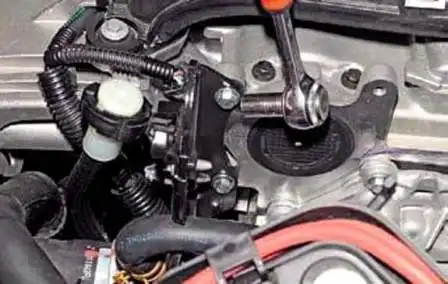
With a head of 8, we unscrew the two bolts securing the engine cooling system hose bracket to the left end of the cylinder head.
Removing the receiver (article - Removing and installing the Renault Duster engine receiver)

With a head of 8, unscrew the nine bolts securing the oil separator to the cylinder head cover

Remove the oil separator
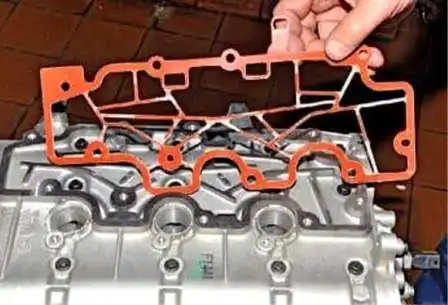
Remove the oil separator gasket

With a head of 8, unscrew the bolts securing the cylinder head cover
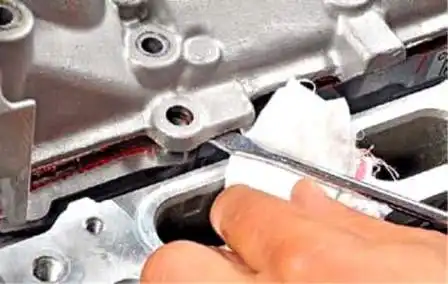
Pry off the cylinder head cover with a flat screwdriver

Removing the camshaft plugs
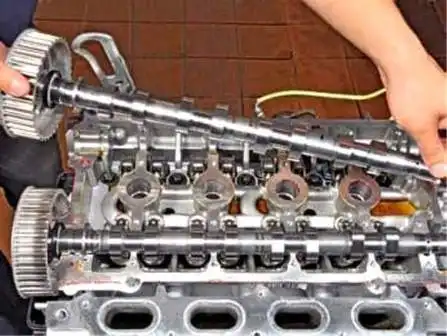
We take out the intake valve shaft from the beds of the cylinder head
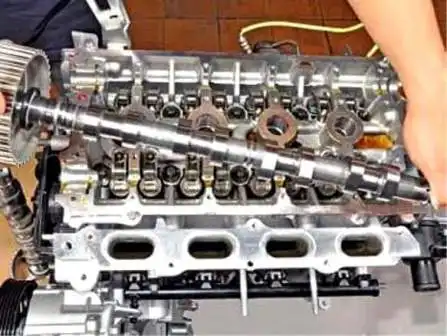
We also remove the exhaust valve shaft
To assess the condition of the valve lever hydraulic bearing:
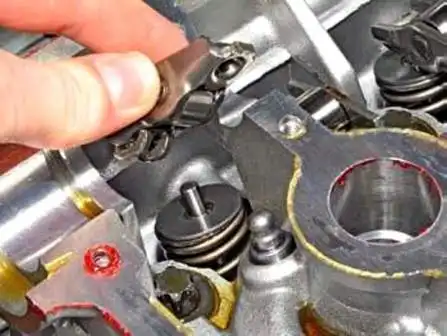
Remove the lever
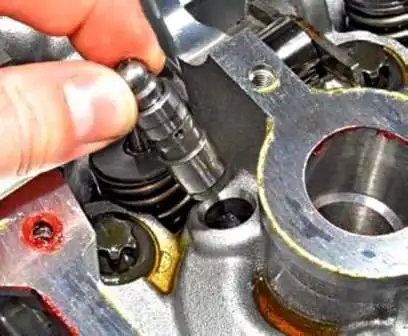
Remove the hydraulic compensator from the socket of the cylinder head.
Checking and flushing the hydraulic bearings is discussed below.
When assembling the timing mechanism, it is necessary to replace the camshaft seals.
To do this, you need to remove the camshaft pulleys.
We put an 18 spanner wrench on the camshaft pulley fastening nut and insert a powerful screwdriver through the hole in the pulley.
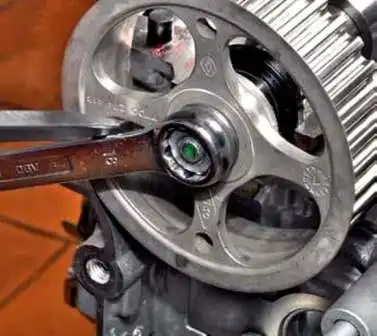
Leaning on the pulley hub with a screwdriver blade, press the key with the screwdriver rod and turn it counterclockwise.
The pulley with the camshaft should not rotate, and the pulley fastening nut will be unscrewed.

Having unscrewed the nut, remove the pulley from the toe of the camshaft

Remove the seal
We also remove the pulley and remove the oil seal from the intake valve shaft of the K4M engine.
On the F4R engine, the intake camshaft pulley is combined with a phase regulator.

To remove the phase regulator, use the Torx T-50 key to unscrew the screw securing the mechanism plug
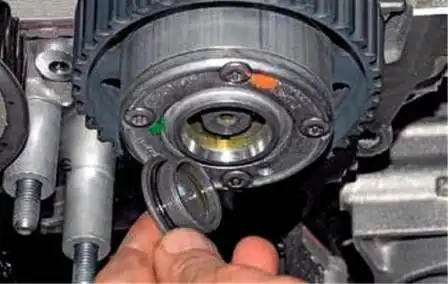
Remove the cap

The connection is sealed with a rubber ring
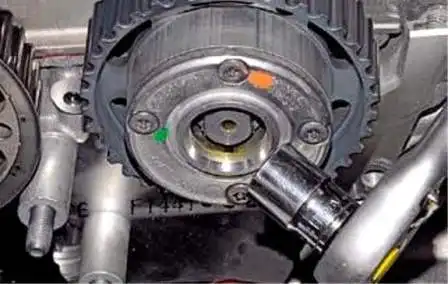
With a head of 18, unscrew the phase regulator mounting bolt
It is possible to fix the shaft from turning with a screwdriver inserted through the hole in the pulley, as described when removing the exhaust valve shaft pulley.
Leaning on the pulley hub with a screwdriver blade, press the screwdriver rod and turn it counterclockwise.
Having unscrewed the bolt, remove the phase regulator.
Before installation, wipe the mating surfaces of the head and head cover.
Apply a special sealant Loctite 518 to the mating surface of the cylinder head until the surface becomes reddish.
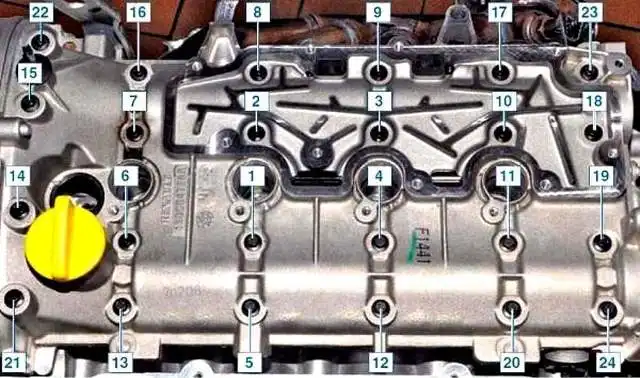
We install the cylinder head cover and tighten the bolts of its fastening to the moment in the sequence indicated in the table.
We apply a thin layer of engine oil to the working edges of the new oil seals and put it on the camshaft toes.
Using a tool head of a suitable size, we press the oil seals into the sockets of the cylinder head.
We check the valve timing using tools (article - removing the timing belt).
Before installing the pulleys on the camshafts, it is necessary to degrease the holes and mating surfaces of the pulleys and shafts.
We wrap the nuts (on the F4R engine - a nut and a bolt) fastening the pulleys, but do not tighten them.
We install on the pulleys and tighten the timing belt (replacing the timing belt article).
Slightly tightening the nuts (on the F4R engine - a nut and bolt) fastening the camshaft pulleys, turn the crankshaft (removing the shaft fixing device) clockwise by two turns and check that the valve timing is set correctly.
Tighten the nuts (on the F4R engine, the nut and bolt) securing the camshaft pulleys.
Cylinder head cover bolt tightening sequence:
- - first stage - tighten bolts 22, 23, 20, 13 to a torque of 8 Nm;
- - second stage - tighten bolts 1 through 12, 14 through 19, 21 through 24 to a torque of 12 Nm;
- - third stage - loosen bolts 22, 23, 20, 13;
- - fourth stage - tighten bolts 22, 23, 20, 13 to a torque of 12 Nm
Tightening torques for other components:
- - camshaft timing pulley fastening nut: first stage at 30 Nm; Second stage 86±6˚.
- - Phase regulator mounting bolt – 100 Nm;
- - Phase regulator plug mounting screw – 25 Nm.
Before installing the oil separator, we clean its channels from deposits.
We clean the mating surfaces from the old gasket and put a new gasket.
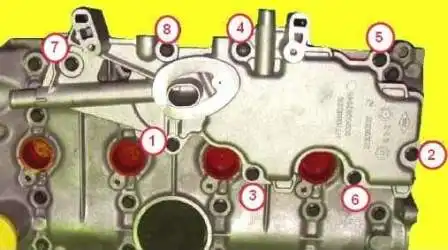
The tightening sequence of the oil separator mounting bolts is shown in the figure.
Tighten the oil separator mounting bolts with a tightening torque of 13 - 15 Nm.
Further assembly is carried out in the reverse order.
Checking and flushing hydraulic valve compensators
The hydraulic gap compensators in the valve drive mechanism are used to compensate for thermal expansion of the drive elements.
The operation of the hydraulic compensator is based on the principle of incompressibility of engine oil, which constantly fills the internal cavity of the hydraulic compensator during engine operation and moves its plunger when a gap appears in the valve drive, ensuring constant contact of the valve drive pressure lever roller with the camshaft cam without gap.
This eliminates the need for valve adjustment during maintenance.
Hydraulic lifters are non-separable compact devices inserted into the sockets of the cylinder head.
Valve knocking of a running engine can be caused by:
- - air ingress into the over-plunger cavities of hydraulic compensators when the oil level in the crankcase is too low or too high, as well as when the car is parked on a slope for a long time;
- - contamination of the precision surfaces of the hydraulic clearance compensators in the valve drive mechanism with sludge from low-quality engine oil (or if it is not replaced in time, as well as if the oil filter is damaged);
- wear of hydraulic lifters.
If pumping or flushing fails to restore the hydraulic compensators, replace them, as their design is non-separable.
Initially, make sure that extraneous noise during engine operation is caused by a malfunction of the hydraulic lifters:
- start the engine.
If the hydraulic compensators fail, extraneous noise in the head cover area appears immediately after the engine is started and changes in accordance with the change in engine speed.
If the noise does not appear immediately after starting the engine or does not change when the crankshaft speed changes, the malfunction is not caused by a malfunction of the hydraulic lifters.
Moreover, if the noise does not change with the change in the speed of the crankshaft, the cause of extraneous noise is probably not in the engine;
- when the engine is idling, make sure that the noise level is not changes when the load changes (for example, when the automatic transmission selector is switched from position N to position D when the clutch of a car with a manual transmission is disengaged or when electrical consumers and air conditioning are turned on).
If the noise level changes, the cause may be a collision of parts due to wear of the connecting rod and main bearings of the crankshaft, and not a malfunction of the hydraulic lifters;
- warm up the engine to operating temperature.
If the noise has decreased or disappeared, the noise of the hydraulic lifters may be caused by oil contamination.
In this case, it is necessary to flush the hydraulic lifters:
- if the noise does not disappear, it is likely that air has entered the hydraulic lifters, and it should be removed.
If the oil level in the crankcase is too low, the oil pump will entrain air along with the oil; if the oil level in the crankcase is too high, the oil is agitated and foamed by the counterweights of the crankshaft.
When the car is parked on a slope for a long time, oil flows out of the cavities of the hydraulic compensators and oil channels, and the supply of oil to the hydraulic compensators after starting the engine takes some time, during which the cavity of the hydraulic compensator has time to get air.
In all these cases, when oil with air enters the over-plunger cavity of the hydraulic compensator, the air inside the cavity when the valve is opened will be compressed and the hydraulic compensator will not be compressed, which will lead to a characteristic knock of the valve mechanism with increased clearances.
To bleed air from the hydraulic lifters, do the following:
Check the oil level in the crankcase and top up if necessary;
- - start the engine and warm it up at idle for 1-3 minutes;
- - increase the crankshaft speed to 3000 min-1, then sharply reduce to idle speed and let the engine idle;
- - repeat the cycle and check if the noise of the valve drive mechanism has disappeared.
If the hydraulic lifters are in good condition, the noise disappears after 10 - 30 cycles;
- - after the noise disappears, repeat to remove air five more times;
- - let the engine idle for 1-3 minutes and make sure that the noise of the valve drive mechanism has disappeared.
If the noise of the valve drive mechanism does not disappear after bleeding and warming up the engine to operating temperature, identify faulty hydraulic lifters as follows.
Shut off the engine and immediately after stopping, set the piston of the 1st cylinder to the TDC position of the compression stroke, remove the cylinder head cover.
Remove the camshafts.
To check the performance of the engine hydraulic compensators, press the shoulder of the rocker arm resting on the hydraulic compensator.
If the rocker arm can be moved with little or no effort, the hydraulic lifter is faulty.
Similarly, check the condition of the hydraulic compensators of the remaining cylinders (the order of operation of cylinders 1-3-4-2).
After identifying faulty hydraulic lifters, you should first try to flush them as follows.
Remove the rocker arms.
Remove the defective hydraulic lifter from the cylinder head socket.
Prepare three identical containers with a capacity of approximately 2 liters for flushing hydraulic lifters.
The dimensions of each container must be sufficient so that the hydraulic compensator, lowered to the bottom of the container in a vertical position, is completely immersed in the liquid.
Fill the containers with clean diesel fuel.
Place the hydraulic lifter in the first container and clean the outer surface.
Having immersed the hydraulic compensator in the first container halfway, with the plunger down, lightly pressing the wire through the hole, squeeze the valve ball and, holding the ball depressed, move the hydraulic compensator plunger 5-10 times until the plunger moves completely free.
If the plunger does not move easily, replace the hydraulic compensator.
Remove the hydraulic compensator from the container and, pressing the valve ball, move the plunger until the diesel fuel flows out of the hydraulic compensator.
Place the hydraulic compensator in the second container and repeat step 5.
Remove the hydraulic compensator from the container and drain the diesel fuel from it as described in step 6.
Place the hydraulic compensator on the bottom of the third container vertically, with the plunger up and wring out the ball of its valve with a wire.
While holding the valve ball depressed, move the plunger down and then slowly move it up so that the over-plunger cavity of the hydraulic compensator is filled with diesel fuel.
Remove the hydraulic compensator from the container, holding it with the plunger up, press the plunger with a little force and make sure that it remains stationary.
At the same time, check the overall height of the hydraulic lifter by comparing it with the new hydraulic lifter.
If during the test it was possible to move the hydraulic compensator plunger, turn Repeat steps 9 and 10 until the hydraulic compensator cavity is completely filled with diesel fuel.
If the hydraulic lifter still does not reach working condition after this, or if its overall height is less than the height of the new hydraulic lifter, replace it.
Before assembling the valve drive mechanism, store filled hydraulic lifters only in the vertical position with the plungers up.
Avoid getting dirt into the hydraulic lifters.
Install hydraulic lifters on the engine as soon as possible after refueling to avoid possible loss of diesel fuel.
Install the hydraulic lifters and all removed parts in the reverse order of removal.
Start the engine and let it idle for 1-3 minutes. If necessary, bleed the hydraulic lifters as described above.





